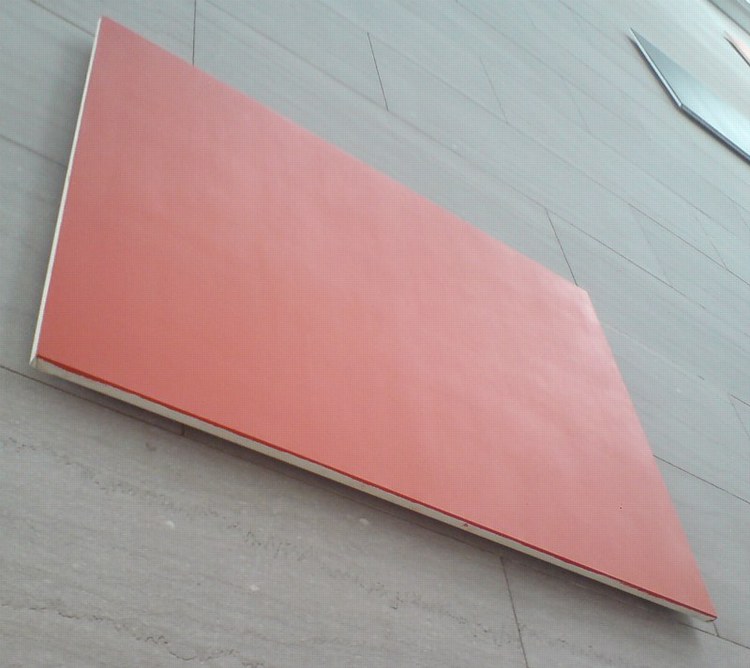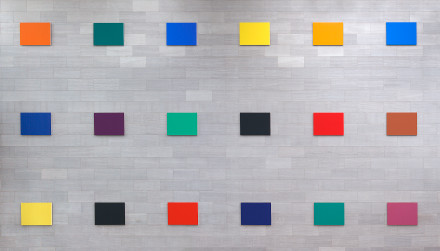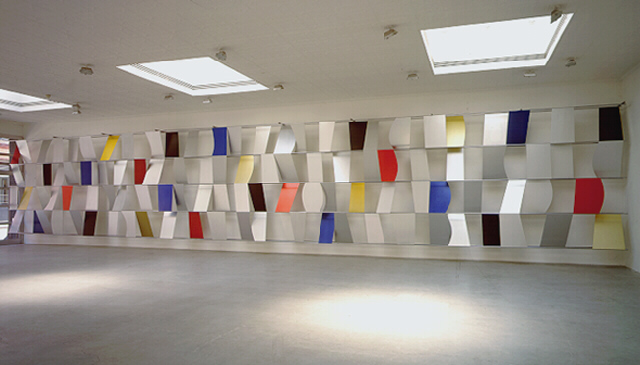
I’ve mentioned Ellsworth Kelly’s Color Panels for a Large Wall before; though they were hard to see up close, the 18-canvases were the only monochromes at the National Gallery that have that tasty, gestureless surface I was craving when I started plotting the Rijksoverheid paintings.

The panels, made in 1978, look so at home there on the giant wall of the East Wing atrium that even though I knew they were a fairly recent acquisition (2005), I somehow never considered they lived anywhere else. So just take a look at that provenance [on the NGA’s newly upgraded website? Congratulations]. They have really been around the block:
Commissioned 1978 by the Central Trust Company, Cincinnati, and installed 1979; gift 1992 to the Cincinnati Art Museum; de-accessioned 1996 and returned to the artist; purchased 30 September 2005 by NGA.
Central Trust Bank’s building in downtown Cincinnati had a 140-foot long wall, where Color Panels were originally installed in two rows of nine. There’s a long, skinny Gemini lithograph from 1979-82 titled 18 Colors (Cincinnati) that gives a flavor for the original configuration:

Reports at the time praised Central Trust’s investment savvy and connoisseurship, joked about color coding the teller windows, and mocked the idea of loaning Kelly’s “paint chips” to an exhibition in Amsterdam. My favorite attempt to explain Kelly’s abstract canvases is this uncredited illustration from Cincinnati Magazine’s coverage of the work’s unveiling, which consisted of three one-dollar bills, each cut into six parts:

So awesome. I’m getting some uncirculated bills first thing in the morning to start working on the edition.
But back to that provenance. Central Trust was bought by PNC Bank in like 1988, which then sold parts of it to Banc One in 1991, which probably explains the gift of Color Panels to the Cincinnati Art Museum in 1992. But what baffles me is the deaccession of such a major work by such a major artist just four years later. Was there just not a wall large enough, not even in the Great Hall, which had been freshly renovated in 1993? I guess not.

image via matthew marks’ artnet page
1996 was a big year for big Kellys. It was when the artist and his dealer Matthew Marks began working to save Kelly’s 1957 anodized aluminum Sculpture For A Large Wall from demolition when Philadelphia’s Penn Center was being remodeled. [Herbert Muschamp rhapsodized about the piece in 1998. Then the Lauders bought it for MoMA. Amusingly, it’s back in Philadelphia right now, for a show at The Barnes.]
It found its way to the East Wing’s 25th anniversary in 2001 as a 2-year loan, reconfigured into three rows of six. “Kelly believes that this incarnation of the piece is preferable to the original.”, the press release said, which probably assuaged Glenstone’s acqisition of it for the museum, which the press release did not say. Anyway, I like it very much and miss it, and wonder what the story is, and why they’re not quite the 4×6 feet they were originally said to be.
Previously: What I looked at today: NGA Monochromes
